Shrimply Explained is currently undergoing renovations. Please don't buy anything yet. Thank you!
A huge reason many shrimp keepers get shrimp is to breed them, whether that’s in hopes of selling the offspring or just to see those cute baby shrimp. Sometimes breeding is incredibly easy because the shrimp you buy/receive might already be carrying eggs. Sometimes, it takes a while though, if it happens at all. The latter scenario is where this article comes in. If your tank lacks the pitter-patter of little shrimplet feet, this article is here to troubleshoot the issue and help you achieve the shrimp tank of your dreams.
Other Shrimp Content
We have a lot of content coming soon. Please follow us on social media and subscribe to our newsletter for updates and useful shrimp care tips!
Challenges in cherry shrimp breeding typically fall into two categories, each with their own causes and solutions:
Let’s tackle these in order, shall we? By the way, hobbyists typically say a pregnant shrimp is “berried” since the eggs look like little berries in her swimmerets.
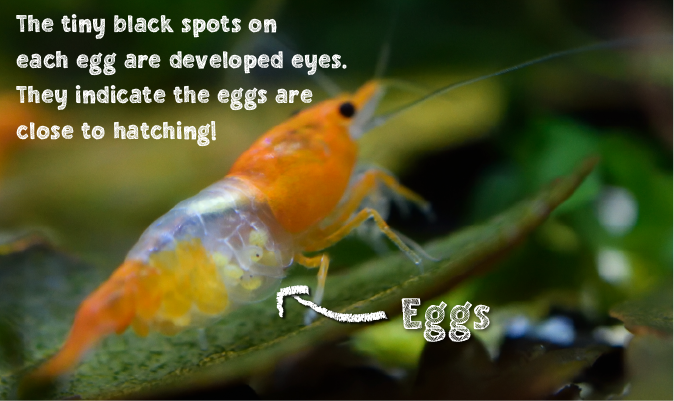
For those of you who don’t know how this whole mating process works, here’s a quick rundown:
When a mommy shrimp and a daddy shrimp love each other very much, they have a romantic dinner together. After that, they wiggle their antennae together and one of the shrimps asks the other for sexual intercourse because they’re scientist shrimp and proper terminology is sexy. After that, it’s banging time and that’s where things get hot--

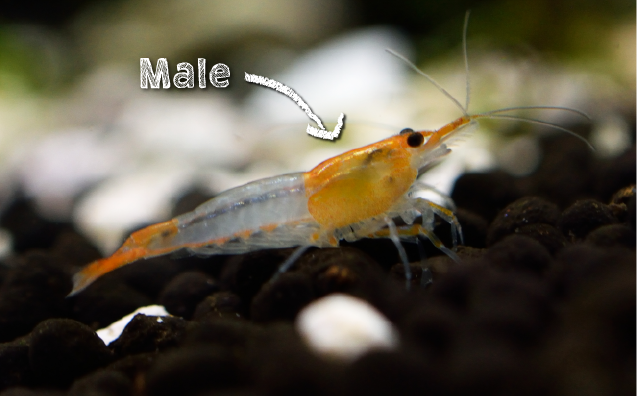
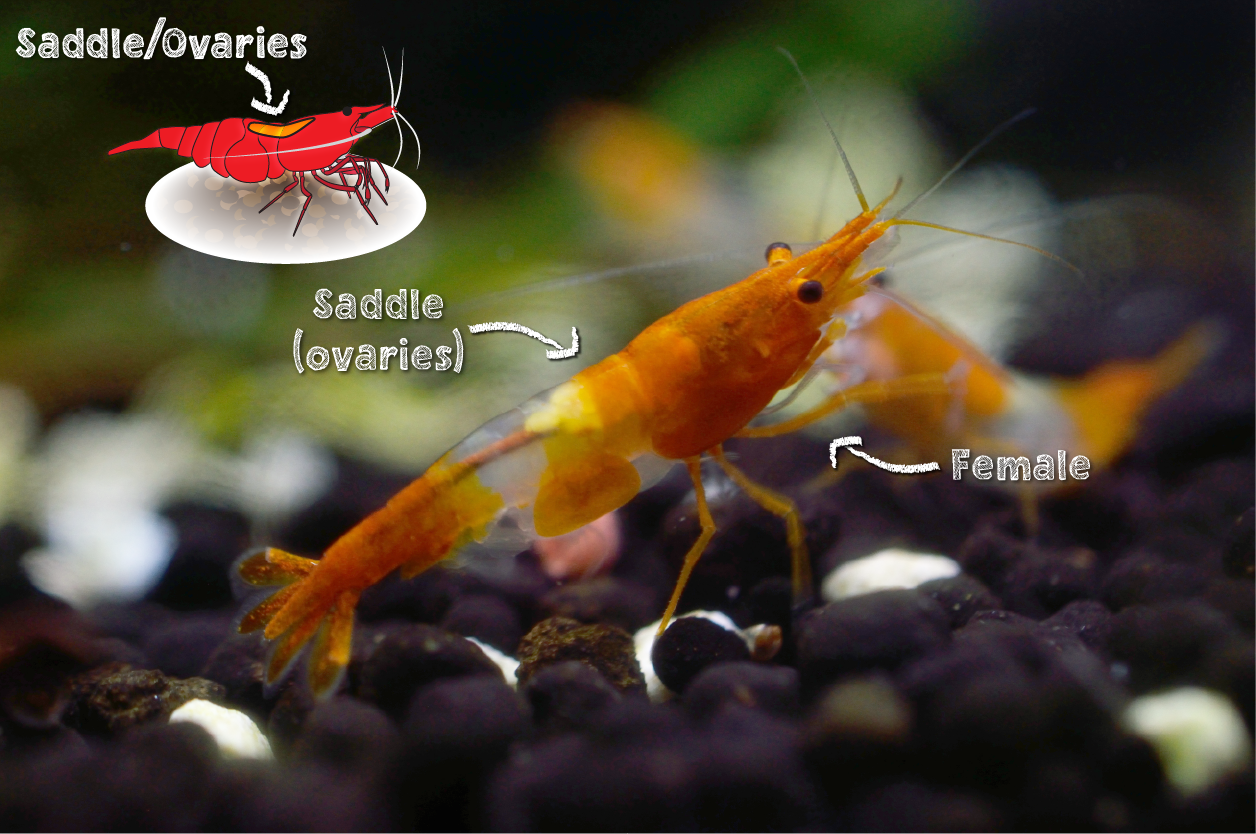
The other (less) common reason your shrimp may not be getting pregnant is if you have all males or all females. Shrimp can only reproduce sexually so both sexes are required for breeding. Now, if you bought 10 shrimp, the chance of receiving only one sex is quite low. Approximately 1 in 1,024 if the shrimp are chosen randomly. If you purchased 5 shrimp, then the chances are 1 in 32, so still low. These are the normal quantities ordered online so buying shrimp online usually results in at least some mix of sexes. That changes if the shrimp are purchased in stores.
In stores, you often have the opportunity to only purchase 2-3 shrimp, making the chance of getting a single sex around ¼ to 1/8. Female shrimp tend to be larger and more colorful so they are often more likely to be chosen in-person, leading to a higher chance of getting all one sex.
If you buy online and especially if you decide to pick shrimp out yourself in stores, it’s important to know how to sex your shrimp. This might explain why your shrimp aren’t breeding.
Once a shrimp is near reproductive age, it becomes possible to sex them. This means that within 1-2 months of receiving your shrimp, you can determine whether you have both males and females. This article explains all the differences between male and female dwarf shrimp like cherry shrimp and crystal red shrimp. Initially, sexing your shrimp can be tough to do but don’t worry – it gets easier!
While this seems like a bit of an odd suggestion, there’s some interesting research that supports the inclusion of bloodworms in your shrimp’s diet to promote pregnancy. This is because bloodworms have a high protein (40-60% dry weight) and fat/cholesterol content (4.5%). Shrimp require protein for growth and cholesterol to produce hormones that control growth and sexual reproduction. They cannot produce cholesterol on their own so require a food source that provides it. Cholesterol and hormones from polychaete worms like bloodworms have been shown to increase egg development in the ovaries of an oceanic shrimp species (Penaeus monodon) and it is not unreasonable to hypothesize they may also do so for freshwater shrimp like Neocaridina. You may also get similar benefits from feeding hard-boiled egg yolk.
If you choose to feed bloodworms, you can either get them frozen or freeze-dried. The freeze-drying process has been shown to degrade cholesterol in products so we recommend frozen bloodworms.
This tip of feeding bloodworms to shrimp originally came from YouTuber FishKeepingAnswers. At first, we were ready with the pitchforks because he provided anecdotal evidence that sounded hard to believe and we thought bloodworms were just fatty or devoid of nutrients, but the research seems to support him. That’s why we have to keep an open mind!
The research says that excess fat in a shrimp’s diet can be detrimental so feeding bloodworms or egg yolk 1-2 times a week may lead to more baby shrimp but these foods should not make up their entire diet.
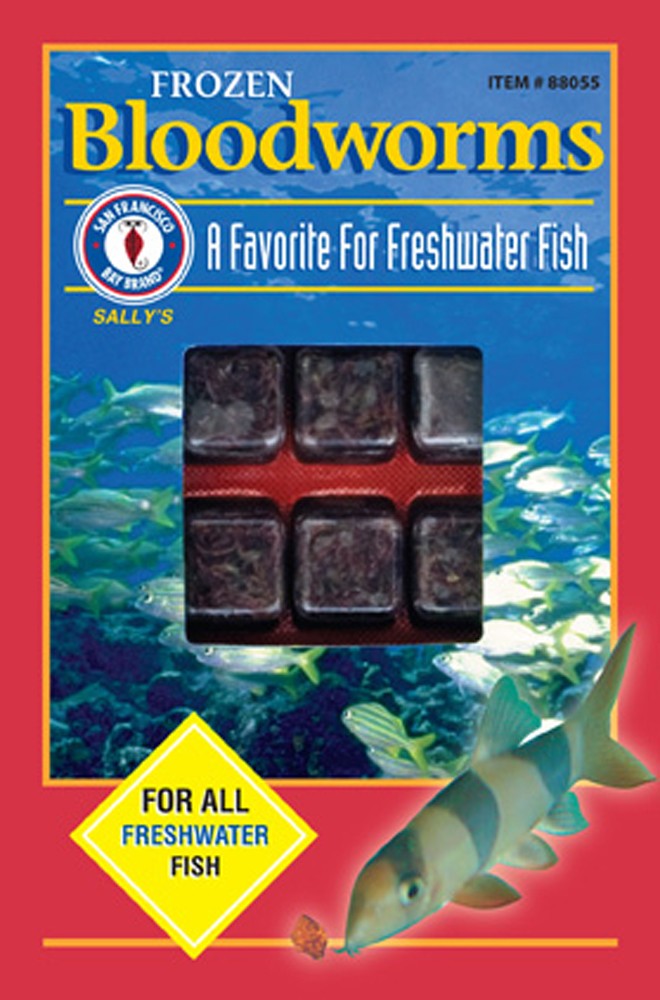
The first important thing to understand is the timeframe of pregnancy for shrimp. Neocaridina hold their eggs in their swimmerets until they hatch, which takes anywhere from 15-30 days depending on temperature (higher temperature > faster hatching). After that, the shrimplets pop out as tiny transparent versions of the adults. They’re only about 1.5-2mm so they can be very difficult to see. It’s totally normal for first-time shrimp keepers to see their female is no longer berried and worry that she dropped her eggs or something killed the babies. While those are possibilities, if you don’t have predators in the tank and don’t see any molts with eggs in them, then the first thing to do is be patient for a couple of weeks. Baby shrimp are hide-and-seek masters that tend to stay in one hiding spot so it’s tough to find them in the first week or two unless you get lucky.
Now, if you still aren’t seeing baby shrimp 3-4 weeks after the female(s) stop carrying eggs, then many of them may not have survived. There are a number of reasons this can happen, all stemming from the facts that baby shrimp are very small and fragile initially.
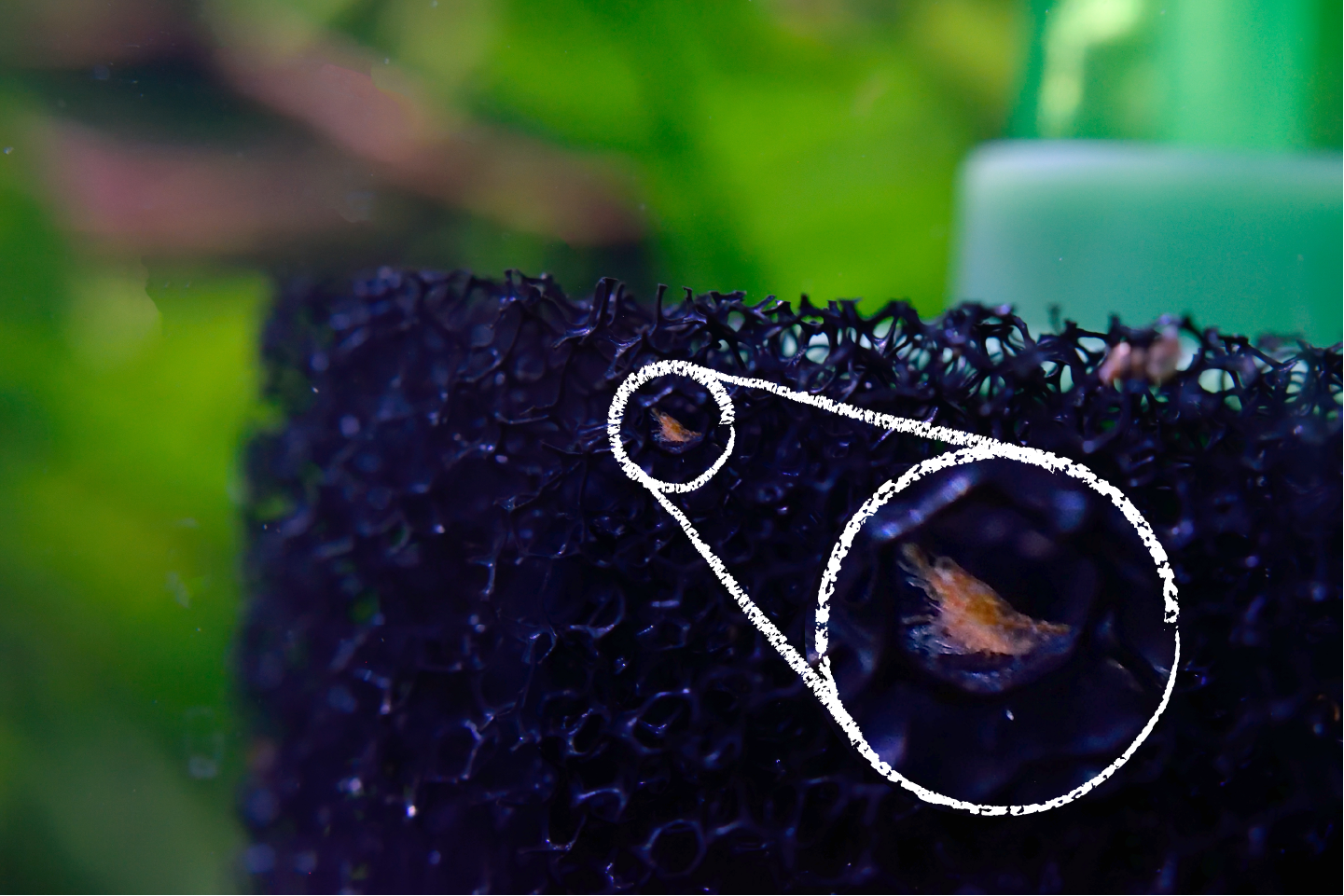
The first troubleshooting step should always be to check parameters. If water parameters are not in healthy ranges, then that drastically decreases your shrimplets’ chance of survival. Again, key parameters are pH, GH, KH, ammonia, nitrites, nitrates, and temperature. Temperature is slightly less of a concern here because dwarf shrimp tend to do well over a wide range, but KH is more critical because baby shrimp are significantly affected by pH swings. Check out this article for more information on how pH and KH are related. You can also take a look at this article to learn how to get the best water for your shrimp.
Fish are the obvious concern here, as any aside from the peaceful Otocinclus may try to fit a tasty shrimplet in their mouth – and the shrimplets rarely find their way back out… The safest thing to do it have a shrimp-only tank but, if you really want fish, then make sure there are plenty of hiding spots for shrimp babies in rocks, substrate, or plants.
On a side note, another fish exception seems to be bristlenose plecos, as a number of YouTubers have been touting success with them in shrimp breeding setups.
Aside from fish, there are other smaller predators that can still be a concern. One concern is an invasion of scuds, which breeders have noticed can eat smaller shrimp. Another predator is hydra, which are these palm-tree-like organisms related to jellyfish. They have sticky stinging tentacles that are not harmful to larger shrimp but may catch and kill baby shrimp. Lastly are planaria, which are flatworms that dig underneath your shrimp’s shell and eat their flesh.
If you see any of these in your tank, then there’s a good chance your baby shrimp’s survival rate is being affected. The good news is that planaria and hydra can be treated relatively easily.
3. Is your filter intake covered?
Hang-on-back (HOB) and canister filters often have large enough inlets that baby shrimp –and sometimes even adult shrimp--can be sucked in. Sometimes, it can be a fun rollercoaster ride where they pop out the other end just fine and other times the ride is deadly. To avoid sucking up shrimp, always put a pre-filter sponge or a mesh fabric over the intake.
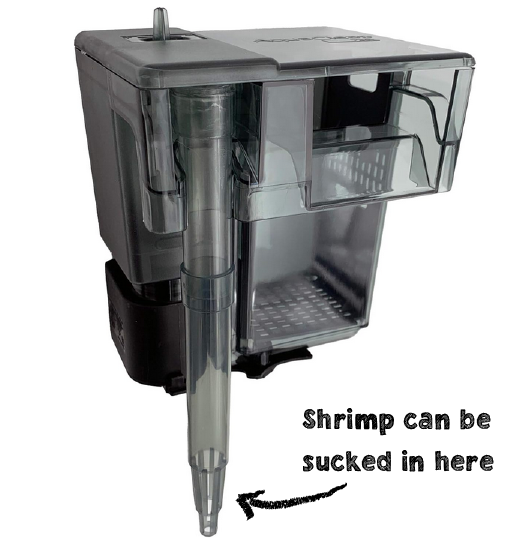
4. Are Your Shrimplets Getting Enough Food?
As we’ve mentioned, baby shrimp tend to hide in the early days of their life. They aren’t going to run to any food you throw into the tank since that crowded area is dangerous for a little shrimp. This often leaves them restricted to a small area in your tank and the area needs to have enough food to support them. The best way to ensure this is to promote biofilm growth in your tank.
Biofilm is this gel-like layer that single-celled organisms excrete once they attach to a surface. This gel protects them from the surrounding environment and happens to be quite nutritious, which is why shrimp spend much of their time scraping it off surfaces in your tank. Biofilm occurs naturally but takes time to develop, which is why we recommend waiting 6-8 weeks after setting up your tank before putting shrimp in it.
Since biofilm is a baby shrimp’s main source of food, the best thing we can do to increase shrimplet survival is to improve our biofilm. You can do this by adding bacterial powder like Glas Garten’s BacterAE into your tank, starting during the cycling process and continuing after adding shrimp. There are a lot of different bacterial powders on the market and there’s no data to say that any single one is better than the others but BacterAE tends to be one of the most widely available and has a clear ingredient list that we’ve evaluated in this article.
Now you know common causes preventing shrimp from breeding, along with a number of different solutions. It may take time and patience but we’re certain you will get to see those cute little shrimplets in your tank :D
If you have any questions or if you want to point out any typos or concerns with the article, we’d love to hear from you on our social media or email (contact@shrimplyexplained.com). If you want to learn more about shrimp keeping, you can also check out The Shrimp School to get the basics of critical concepts.
Good luck and happy shrimpin’!
Pssst... Want to learn everything you need to know to have happy and healthy freshwater shrimp? We've got you covered with clear, concise, and fun information in every lesson of The Shrimp School!
You know it's true because we have a badge.